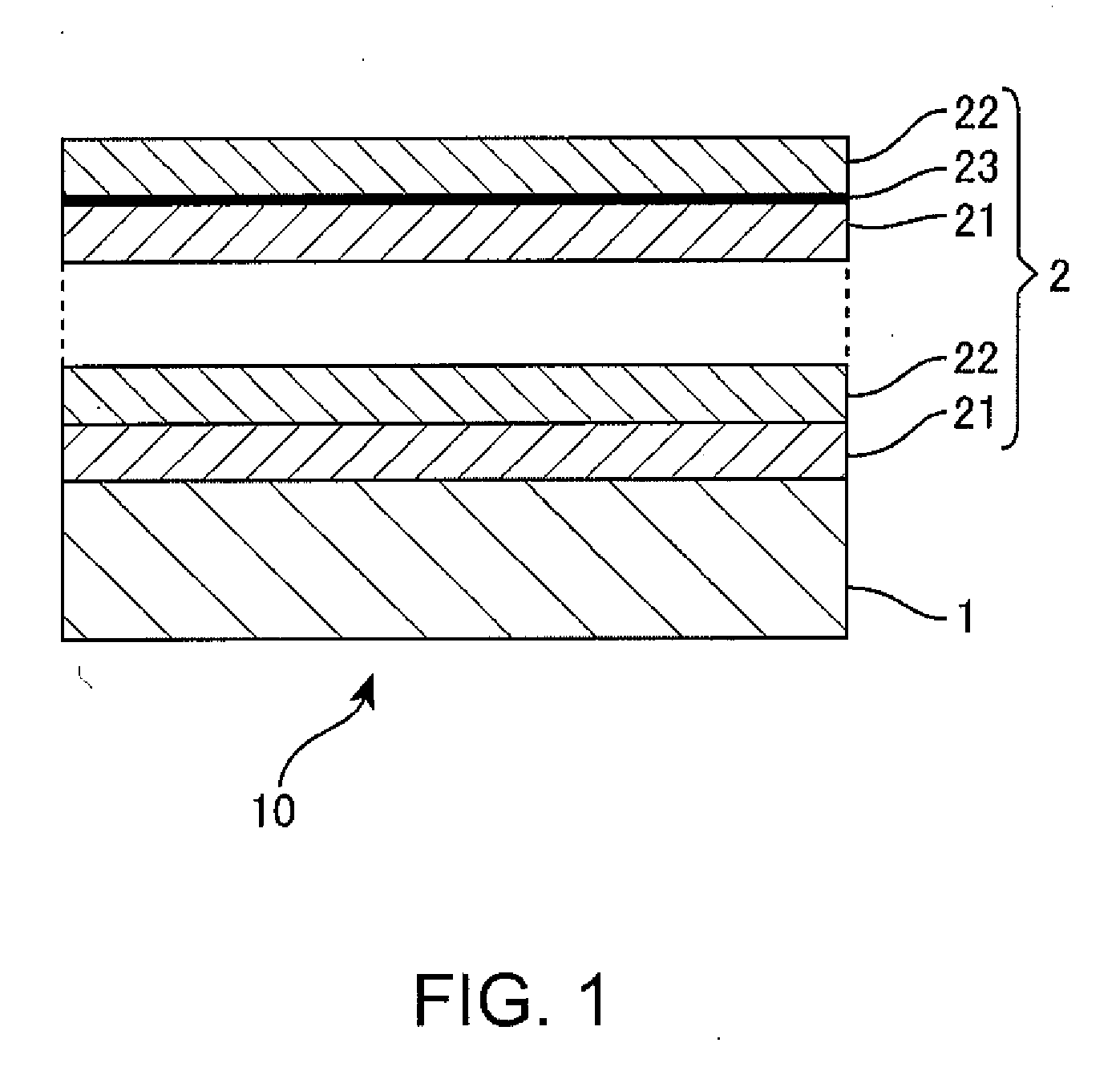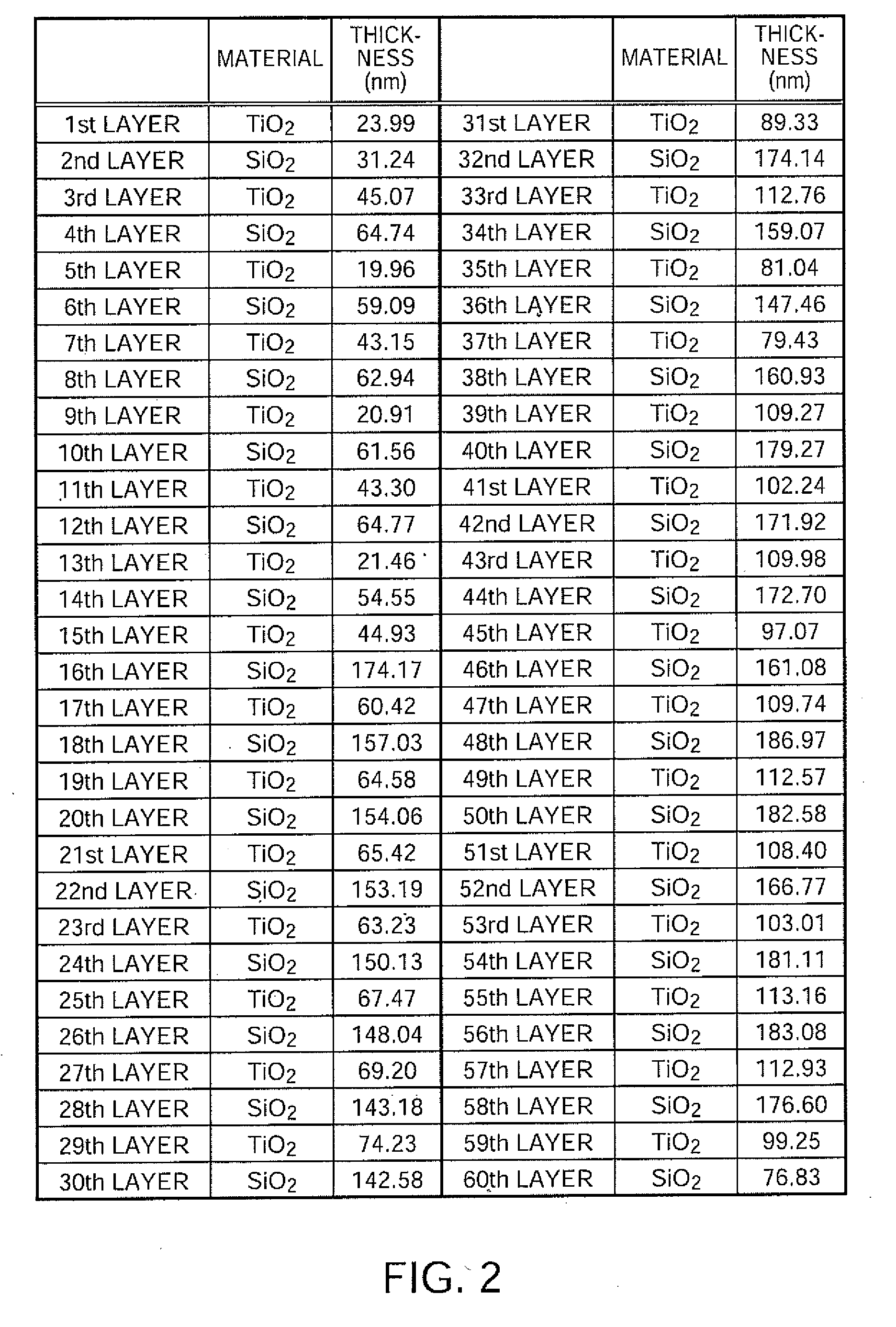Optical Article and Method for Producing the Same
a technology of optical articles and optical elements, applied in the field of optical articles, can solve the problems of low resistance of compounds and production costs, and achieve the effects of reducing the resistance of the surface of the first layer, low cost, and reducing the resistance of the first layer (surface region)
- Summary
- Abstract
- Description
- Claims
- Application Information
AI Technical Summary
Benefits of technology
Problems solved by technology
Method used
Image
Examples
example 1
Sample S1
[0040]The substrate 1 herein is a glass substrate for transmitting light. In Example 1, a clear glass (B270) with a refractive index of 1.53 was used. Further, a filter layer 2 of an inorganic thin film was formed on the substrate 1 by ordinary ion-assisted, electron beam deposition (so-called IAD method), giving an optical multilayer filter 10. In Example 1, high-refractive-index layers 21 in the filter layer 2 are titanium oxide (TiO2) layers, and low-refractive-index layers 22 are silicon dioxide (SiO2) layers. Specifically, the substrate 1 was placed in a vacuum deposition chamber (not illustrated). A crucible fined with a deposition material was then placed at the bottom of the vacuum deposition chamber, and evaporated by an electron beam. Simultaneously, ionized oxygen was accelerated and irradiated using an ion gun (Ar was added in the case of TiO2 film formation), thereby alternately forming films to the thickness shown in FIG. 2.
[0041]The conditions for forming TiO...
example 2
Sample S2
[0056]In the same manner as in Example 1, an optical multilayer filter 10 including a filter layer 2 with the same structure as in Example 1 was produced. However, the conditions for reducing resistance are as follows.
Conditions for Reducing Resistance (Sample S2)
[0057]Subject layer: TiO2
Added composition: Silicon
Treatment time: 10 seconds
Ion irradiation conditions
[0058]Accelerating voltage: 500 V
[0059]Accelerating current: 150 mA
[0060]Ar flow rate: 20 sccm
Treatment temperature: 150° C.
[0061]After the filter layer 2 was formed, oxygen plasma treatment was performed. Subsequently, in a deposition apparatus, a high-molecular-weight, fluorine-containing organosilicon compound “KY-130” (trade name, manufactured by Shin-Etsu Chemical) was deposited to form an antifouling layer on the filter layer 2. Specifically, a pellet material containing the fluorine-containing organosilicon compound, as the deposition source, was heated at about 500° C. to form the antifouling layer. The d...
example 3
Sample S3
[0062]In the same manner as in Example 1, an optical multilayer filter 10 including a filter layer 2 with the same structure as in Example 1 was produced. However, the conditions for reducing resistance are as follows.
Conditions for Reducing Resistance (Sample S3)
[0063]Subject layer: TiO2
Added composition: Germanium
Treatment time: 10 seconds
Ion irradiation conditions
[0064]Accelerating voltage: 800 V
[0065]Accelerating current: 150 mA
[0066]Ar flow rate: 20 sccm
Treatment temperature: 150° C.
PUM
 Login to View More
Login to View More Abstract
Description
Claims
Application Information
 Login to View More
Login to View More - R&D
- Intellectual Property
- Life Sciences
- Materials
- Tech Scout
- Unparalleled Data Quality
- Higher Quality Content
- 60% Fewer Hallucinations
Browse by: Latest US Patents, China's latest patents, Technical Efficacy Thesaurus, Application Domain, Technology Topic, Popular Technical Reports.
© 2025 PatSnap. All rights reserved.Legal|Privacy policy|Modern Slavery Act Transparency Statement|Sitemap|About US| Contact US: help@patsnap.com



